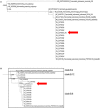Revisiting Francisella tularensis subsp. holarctica, Causative Agent of Tularemia in Germany With Bioinformatics: New Insights in Genome Structure, DNA Methylation and Comparative Phylogenetic Analysis
- PMID: 29593661
- PMCID: PMC5859110
- DOI: 10.3389/fmicb.2018.00344
Revisiting Francisella tularensis subsp. holarctica, Causative Agent of Tularemia in Germany With Bioinformatics: New Insights in Genome Structure, DNA Methylation and Comparative Phylogenetic Analysis
Abstract
Francisella (F.) tularensis is a highly virulent, Gram-negative bacterial pathogen and the causative agent of the zoonotic disease tularemia. Here, we generated, analyzed and characterized a high quality circular genome sequence of the F. tularensis subsp. holarctica strain 12T0050 that caused fatal tularemia in a hare. Besides the genomic structure, we focused on the analysis of oriC, unique to the Francisella genus and regulating replication in and outside hosts and the first report on genomic DNA methylation of a Francisella strain. The high quality genome was used to establish and evaluate a diagnostic whole genome sequencing pipeline. A genotyping strategy for F. tularensis was developed using various bioinformatics tools for genotyping. Additionally, whole genome sequences of F. tularensis subsp. holarctica isolates isolated in the years 2008-2015 in Germany were generated. A phylogenetic analysis allowed to determine the genetic relatedness of these isolates and confirmed the highly conserved nature of F. tularensis subsp. holarctica.
Keywords: Francisella tularensis subsp. holarctica; genome analysis; high quality genome; phylogeny; tularemia.
Figures





Similar articles
-
Genetic Diversity and Spatial Segregation of Francisella tularensis Subspecies holarctica in Germany.Front Cell Infect Microbiol. 2019 Nov 6;9:376. doi: 10.3389/fcimb.2019.00376. eCollection 2019. Front Cell Infect Microbiol. 2019. PMID: 31781515 Free PMC article.
-
[Determination of the Subspecies of Francisella tularensis Isolated in Turkey by Molecular Methods].Mikrobiyol Bul. 2020 Jan;54(1):1-10. doi: 10.5578/mb.68784. Mikrobiyol Bul. 2020. PMID: 32050874 Turkish.
-
Francisella tularensis Subspecies holarctica and Tularemia in Germany.Microorganisms. 2020 Sep 22;8(9):1448. doi: 10.3390/microorganisms8091448. Microorganisms. 2020. PMID: 32971773 Free PMC article. Review.
-
Genotyping of Francisella tularensis subsp. holarctica from Hares in Germany.Microorganisms. 2020 Dec 5;8(12):1932. doi: 10.3390/microorganisms8121932. Microorganisms. 2020. PMID: 33291395 Free PMC article.
-
Genotyping of Francisella tularensis, the causative agent of tularemia.J AOAC Int. 2010 Nov-Dec;93(6):1930-43. J AOAC Int. 2010. PMID: 21313823 Review.
Cited by
-
Antimicrobial Susceptibility and Genomic Analysis of Aliarcobacter cibarius and Aliarcobacter thereius, Two Rarely Detected Aliarcobacter Species.Front Cell Infect Microbiol. 2021 Mar 17;11:532989. doi: 10.3389/fcimb.2021.532989. eCollection 2021. Front Cell Infect Microbiol. 2021. PMID: 33816322 Free PMC article.
-
Testing assembly strategies of Francisella tularensis genomes to infer an evolutionary conservation analysis of genomic structures.BMC Genomics. 2021 Nov 14;22(1):822. doi: 10.1186/s12864-021-08115-x. BMC Genomics. 2021. PMID: 34773979 Free PMC article.
-
Genome sequence of a pathogenic Corynebacterium ulcerans strain isolated from a wild boar with necrotizing lymphadenitis.BMC Res Notes. 2019 Oct 25;12(1):692. doi: 10.1186/s13104-019-4704-3. BMC Res Notes. 2019. PMID: 31653224 Free PMC article.
-
Using affinity propagation clustering for identifying bacterial clades and subclades with whole-genome sequences of Francisella tularensis.PLoS Negl Trop Dis. 2020 Sep 29;14(9):e0008018. doi: 10.1371/journal.pntd.0008018. eCollection 2020 Sep. PLoS Negl Trop Dis. 2020. PMID: 32991594 Free PMC article.
-
Antimicrobial Susceptibility and Genomic Structure of Arcobacter skirrowii Isolates.Front Microbiol. 2018 Dec 14;9:3067. doi: 10.3389/fmicb.2018.03067. eCollection 2018. Front Microbiol. 2018. PMID: 30619152 Free PMC article.
References
LinkOut - more resources
Full Text Sources
Other Literature Sources
Miscellaneous

